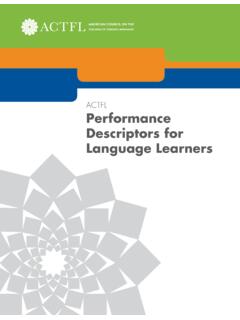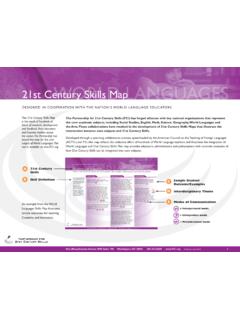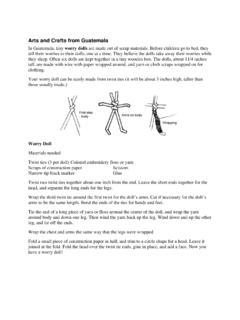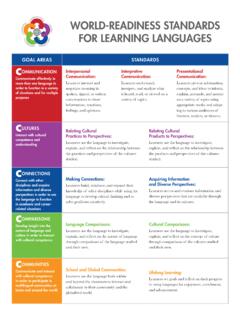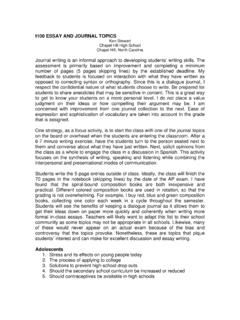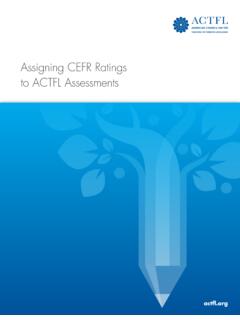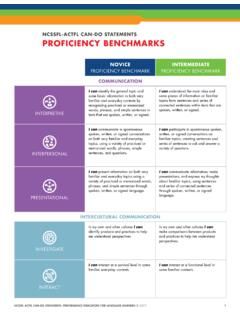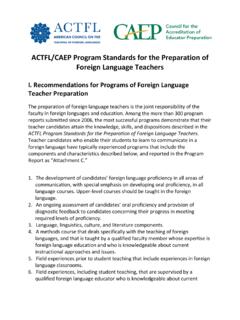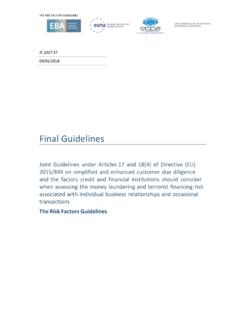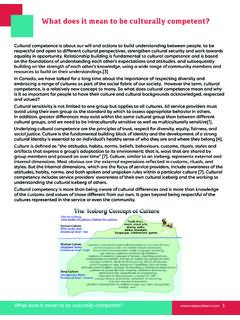Transcription of ACTFL PROFICIENCY GUIDELINES 2012
1 1 | ACTFL PROFICIENCY GUIDELINES 2012 ACTFL , INC., 2012 ACTFL PROFICIENCY GUIDELINES2 012 AMERICAN COUNCIL ON THE TEACHING OF FOREIGN LANGUAGES 1001 N. FAIRFAX ST., SUITE 200 | ALEXANDRIA, VA 22314ph 703-894-2900 | fax 703-894-2905 | | ACTFL PROFICIENCY GUIDELINES 2012 ACTFL , INC., 2012 ACKNOWLEDGMENTSACTFL is deeply indebted to the many individuals who contributed to the previous editions of the PROFICIENCY GUIDELINES . In addition, ACTFL wishes to acknowledge the principal authors and editors of this 3rd Edition of the PROFICIENCY GUIDELINES : Elvira Swender, Daniel J. Conrad, and Robert Vicars; and the invaluable contributions of the project consultants: Mahdi Alosh, Karen Breiner-Sanders, Ray T. Clifford, Helen Hamlyn, David Hiple, Judith Liskin-Gasparro, Pardee Lowe, Jr., Cynthia Martin, Karl F. Otto, Jr., Benjamin Rifkin, Mildred Rivera-Martinez, and Erwin , ACTFL is most appreciative of the comments and feedback from the many members of the profession who contributed generously of their time and expertise in reviewing earlier drafts of this ACTFL PROFICIENCY GUIDELINES 2012 may be used for non-profit, educational purposes only, provided that they are reproduced in their entirety, with no alterations, and with credit to | ACTFL PROFICIENCY GUIDELINES 2012 ACTFL , INC.
2 , 2012 General Prefaceto the ACTFL PROFICIENCY GUIDELINES 2012 The ACTFL PROFICIENCY GUIDELINES are descriptions of what individuals can do with language in terms of speaking, writing, listening, and reading in real-world situations in a spontaneous and non-rehearsed context. For each skill, these GUIDELINES identify five major levels of PROFICIENCY : Distinguished, Superior, Advanced, Intermediate, and Novice. The major levels Advanced, Intermediate, and Novice are subdivided into High, Mid, and Low sublevels. The levels of the ACTFL GUIDELINES describe the continuum of PROFICIENCY from that of the highly articulate, well-educated language user to a level of little or no functional ability. These GUIDELINES present the levels of PROFICIENCY as ranges, and describe what an individual can and cannot do with language at each level, regardless of where, when, or how the language was acquired.
3 Together these levels form a hierarchy in which each level subsumes all lower levels. The GUIDELINES are not based on any particular theory, pedagogical method, or educational curriculum. They neither describe how an individual learns a language nor prescribe how an individual should learn a language, and they should not be used for such purposes. They are an instrument for the evaluation of functional language ability. The ACTFL PROFICIENCY GUIDELINES were first published in 1986 as an adaptation for the academic community of the Government s Interagency Language Roundtable (ILR) Skill Level Descriptions. This third edition of the ACTFL PROFICIENCY GUIDELINES includes the first revisions of Listening and Reading since their original publication in 1986, and a second revision of the ACTFL Speaking and Writing GUIDELINES , which were revised to reflect real-world assessment needs in 1999 and 2001 respectively.
4 New for the 2012 edition are the addition of the major level of Distinguished to the Speaking and Writing GUIDELINES , the division of the Advanced level into the three sublevels of High, Mid, and Low for the Listening and Reading GUIDELINES , and the addition of a general level description at the Advanced, Intermediate, and Novice levels for all skills. Another new feature of the 2012 GUIDELINES is their publication online, supported with glossed terminology and annotated, multimedia samples of performance at each level for Speaking and Writing, and examples of oral and written texts and tasks associated with each level for Reading and direct application of the ACTFL PROFICIENCY GUIDELINES is for the evaluation of functional language ability. The GUIDELINES are intended to be used for global assessment in academic and workplace settings. However, the GUIDELINES do have instructional implications.
5 The ACTFL PROFICIENCY GUIDELINES underlie the development of the ACTFL Performance GUIDELINES for K-12 Learners (1998) and are used in conjunction with the National Standards for Foreign Language Learning (1996, 1998, 2006) to describe how well students meet content standards. For the past 25 years, the ACTFL GUIDELINES have had an increasingly profound impact on language teaching and learning in the United | ACTFL PROFICIENCY GUIDELINES 2012 ACTFL , INC., 2012 DISTINGUISHEDS peakers at the Distinguished level are able to use language skillfully, and with accuracy, efficiency, and effectiveness. They are educated and articulate users of the language. They can reflect on a wide range of global issues and highly abstract concepts in a culturally appropriate manner. Distinguished-level speakers can use persuasive and hypothetical discourse for representational purposes, allowing them to advocate a point of view that is not necessarily their own.
6 They can tailor language to a variety of audi-ences by adapting their speech and register in ways that are culturally at the Distinguished level produce highly sophisticated and tightly organized extended discourse. At the same time, they can speak succinctly, often using cultural and historical references to allow them to say less and mean more. At this level, oral discourse typically resembles written non-native accent, a lack of a native-like economy of expression, a limited control of deeply embedded cultural references, and/or an occasional isolated language error may still be present at this level. PrefaceThe ACTFL PROFICIENCY GUIDELINES 2012 Speaking describe five major levels of PROFICIENCY : Distinguished, Superior, Advanced, Intermediate, and Novice. The description of each ma-jor level is representative of a specific range of abilities. Together these levels form a hierarchy in which each level subsumes all lower levels.
7 The major levels Advanced, Intermediate, and Novice are divided into High, Mid, and Low sublevels. The GUIDELINES describe the tasks that speakers can handle at each level, as well as the content, context, accuracy, and discourse types associated with tasks at each level. They also present the limits that speakers encounter when attempting to function at the next higher major level. These GUIDELINES can be used to evaluate speech that is either Interpersonal (interactive, two-way communication) or Presentational (one-way, non-interactive).The written descriptions of speaking PROFICIENCY are accompanied online by speech samples illustrating the features of each major level. The ACTFL PROFICIENCY GUIDELINES 2012 Speaking may be used for non-profit, educational purposes only, pro-vided that they are reproduced in their entirety, with no alterations, and with credit to PROFICIENCY GUIDELINES 2 012 SPEAKING5 | ACTFL PROFICIENCY GUIDELINES 2012 ACTFL , INC.
8 , 2012 SUPERIORS peakers at the Superior level are able to communicate with accuracy and fluency in order to participate fully and effectively in conversations on a variety of topics in formal and informal settings from both concrete and abstract perspectives. They discuss their interests and special fields of competence , explain complex matters in detail, and provide lengthy and coherent narrations, all with ease, fluency, and accuracy. They present their opinions on a number of issues of interest to them, such as social and political issues, and provide structured arguments to support these opinions. They are able to construct and develop hypotheses to explore alternative possibilities. When appropriate, these speakers use extended discourse without unnaturally lengthy hesitation to make their point, even when en-gaged in abstract elaborations. Such discourse, while coherent, may still be influenced by language patterns other than those of the target language.
9 Superior-level speakers employ a variety of interactive and discourse strategies, such as turn-taking and separating main ideas from supporting information through the use of syntactic, lexical, and phonetic at the Superior level demonstrate no pattern of error in the use of basic structures, although they may make sporadic errors, particu-larly in low-frequency structures and in complex high-frequency structures. Such errors, if they do occur, do not distract the native interlocutor or interfere with commu at the Advanced level engage in conversation in a clearly participatory manner in order to communicate information on au-tobiographical topics, as well as topics of community, national, or international interest. The topics are handled concretely by means of narration and description in the major times frames of past, present, and future. These speakers can also deal with a social situa-tion with an unexpected complication.
10 The language of Advanced-level speakers is abundant, the oral paragraph being the measure of Advanced-level length and discourse. Advanced-level speakers have sufficient control of basic structures and generic vocabulary to be understood by native speakers of the language, including those unaccustomed to non-native HighSpeakers at the Advanced High sublevel perform all Advanced-level tasks with linguistic ease, confidence, and compe-tence. They are consistently able to explain in detail and narrate fully and accurately in all time frames. In addition, Ad-vanced High speakers handle the tasks pertaining to the Superior level but cannot sustain performance at that level across a variety of topics. They may provide a structured argument to support their opinions, and they may construct hypotheses, but patterns of error appear. They can discuss some topics abstractly, especially those relating to their particular interests and special fields of expertise, but in general, they are more comfortable discussing a variety of topics High speakers may demonstrate a well-developed ability to compensate for an imperfect grasp of some forms or for limitations in vocabulary by the confident use of communicative strategies, such as paraphrasing, circumlocution, and illustra-tion.
